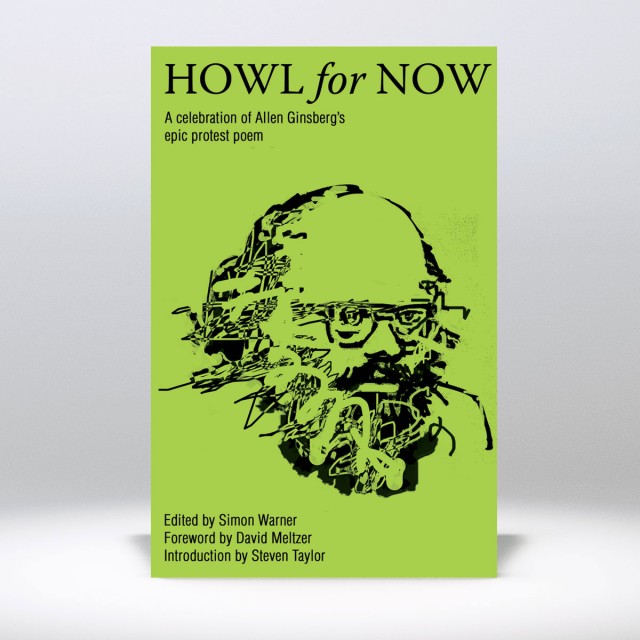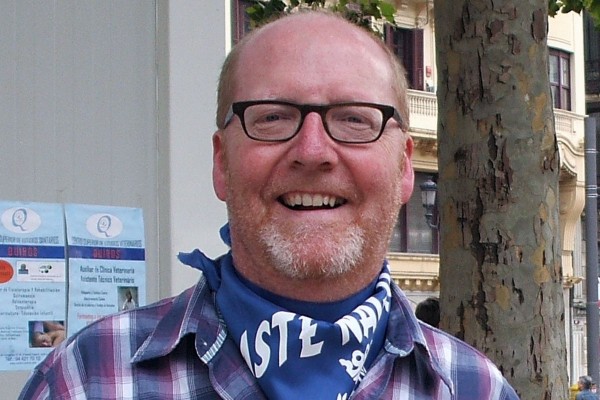A Celebration of Allen Ginsberg’s Epic Protest Poem
On October 7th, 1955, a little known poet called Allen Ginsberg premiered a new long poem in the Six Gallery in San Francisco. ‘Howl’, penned in the shadow of the Cold War, would cause a sensation among the crowd that gathered that evening. It would not be long before the poem’s impact spread far beyond the confines of the Bay Area literary scene to a national and international readership. Within a year, ‘Howl’ would be published by famed independent publisher City Lights. In the decades that followed, the piece would become possibly the most influential poem in American culture, certainly the most widely read.
Ginsberg’s masterpiece is a cornerstone of the dynamic and radical literature produced by the so-called Beat Generation and its resonance is still felt today. In Howl for Now, academics, commentators and practitioners reflect on the power of ‘Howl’, half a century on from Ginsberg’s historic first reading, through a series of essays and interviews. Poet David Meltzer reflects on the San Francisco scene in the mid-1950s, Ginsberg collaborator Steven Taylor offers a personal memoir, film director Ronald Nameth and rock composer Bill Nelson contemplate a documentary version of ‘Howl’, and members of the University of Leeds, in the UK, consider the political, cultural and aesthetic place of the poem as both a social document and a point of contemporary inspiration.
Paperback
Included in our 3 for 2 offer on backlist titles. Add this and two other backlist titles to the shopping basket and enter voucher code 3FOR2 at the checkout.
Sifting the Shifting Sands
In this extract from Howl For Now, Simon Warner considers the significance of the debut of 'Howl' and Bill Haley's 'Rock Around The Clock' as bellwethers for the changing cultural landscape of America.
On October 7th, 1955 in the Six Gallery in downtown San Francisco, an emerging but little known poet called Allen Ginsberg stood to deliver a new long poem he had been working on over the previous months. ‘Howl’, read to a small, if packed, crowd of friends and supporters, would-be novelists and ambitious young poets, was an immediate sensation. The listeners greeted the piece, an impassioned statement touching upon issues as broad as the Cold War, homosexuality, Buddhism and jazz, drugs, the supernatural and suicide, with a huge and enthusiastic ovation. Said Jonah Raskin in his book American Scream: Allen Ginsberg’s ‘Howl’ and the Making of the Beat Generation: ‘The audience was transformed […] indifferent spectators becoming energetic participants […] No one had been to a poetry reading that was so emotional and so cathartic’ (2004, p18).
Several of the writers in attendance would actually go away and write their own first-hand account of what had gone on that evening – Jack Kerouac would fictionalise the occasion in his 1958 novel The Dharma Bums, for example – a suggestion in itself that there was a strong sense a piece of history, a memorable literary moment, had been played out on that autumn night. ‘In all of our memories no one had been so outspoken in poetry before,’ wrote another poet Michael McClure after the reading. ‘We had gone beyond a point of no return – and we were ready for it, for a point of no return’ (McClure, 1982, p13). An underground gathering of subterranean scribes and street philosophers, the so-called Beat Generation, had raised its head above the parapet.
With ‘Howl’, Ginsberg marked his arrival as a writer of profile and status. For more than ten years he had endured uncertain progress – acceptance then expulsion from the Ivy League campus of Columbia in New York, his involvement with the under-classes of Manhattan and his fringe contributions to their criminal activities, a period under the scrutiny of the asylum, his visionary episodes in which he believed he had encountered William Blake and his time as an employee of the Madison Avenue advertising industry – was behind him; his life as poet had commenced. The day after the Six Gallery reading, Lawrence Ferlinghetti, the proprietor of City Lights bookshop and its emerging publishing operation, would acknowledge Ginsberg’s achievement with scant delay. Ferlinghetti, referencing words that Ralph Waldo Emerson had penned to Walt Whitman in praise of Leaves of Grass in 1855, exactly 100 years before, wrote to Ginsberg: ‘I greet you at the beginning of a great career. When do I get the manuscript?’ (Raskin, 2004, p19).
While this new era would not be without its accompanying difficulties – the acclaimed piece would indeed be published by City Lights the following year as Howl and Other Poems only to face obscenity charges and a high profile court case within months – the breakthrough that ‘Howl’ represented was enormous, not only for the writer of the poem but also those in Ginsberg’s circle. His friends Kerouac and William Burroughs would gain immensely from the poet’s national, then international, recognition. Ginsberg had been and remained a tireless promoter of his fellow writers’ novels. He had helped Burroughs to publish his debut book, Junkie in 1953, and would continue to push his much more difficult, experimental works like The Naked Lunch as the Fifties turned into the Sixties. For Kerouac, ‘Howl’ was like the fanfare before the curtain rose and the stage illuminated, for Ginsberg made mention of his friend’s numerous unpublished novels in the preface to the poem and included him among several dedicatees. In 1957, On the Road, the major novel of this tight-knit gathering of writers, would appear and cause a sensation. The Beats, a community known essentially to its core members only before the mid-1950s, would swiftly become a literary grouping familiar to hundreds and thousands of readers around the globe in the months and years that would follow.
Yet if writers and poets of a fresh vein were beginning to make their mark at this moment, there were other significant forces at play on a shifting American landscape. By the time Ginsberg premiered his soon-to-be published poem, a significant record was coming to the end of a six month stay in the Top 40, the American Billboard chart which had become the standard weekly sales listing for pop songs from 1940. Bill Haley and His Comets’ single (‘We’re Gonna) Rock Around the Clock’ – also widely described in its shortened version of ‘Rock Around the Clock’ – had entered the chart on April 15th, 1955 and would remain in that list for the next 24 weeks (Whitburn, 1983, p129). During its stay it would also enjoy 8 weeks in the Number 1 position, a significant indicator that this record had entered and remained part of the national psyche for some considerable time.
Why was this of importance? This was not Haley’s first chart entry: Palmer credits his 1953 release ‘Crazy Man Crazy’ as ‘the first white rock and roll hit’ (1996, p25) and, at the end of 1954, Ward states that ‘Shake, Rattle and Roll’, a bowdlerised version of a Big Joe Turner hit, ‘shot up the Top Ten – not only in the United States but also in England, where teenagers were apparently awaiting this blast of new music just as avidly as Americans were’ (1987, pp 89-90). But ‘Rock Around the Clock’ left a deeper imprint because not only was it heard on record players and radios but had also been featured in an acclaimed and widely-seen movie of 1955, The Blackboard Jungle, a school-based drama starring Glenn Ford which had utilised music – jazz versus rock’n’roll – as a metaphor for the generation gap. The film, based on a novel by Evan Hunter concerned ‘a new teacher at a high school in a “bad” section of town [who] is taunted and abused by a group of his students (including a black one played by Sidney Poitier)’ (Ward, 1987, p106). A fellow teacher also endures the ignominy of having his jazz records smashed by a members of his class (ibid).
Why though should we attempt to elide these two works, ‘Howl’ and ‘Rock Around the Clock’, a piece of poetry and a song? Why should a connection be made between an un-minted poem, known to but a dedicated few, and a hugely successful pop record, familiar to millions across the States? This chapter will argue that both of these expressions were symptomatic of an America that was undergoing a period of dramatic transition. While Ginsberg’s verse and Haley’s song were coming from different intellectual places, and appealing to different sections of society, they were symbols of that metamorphosis. These two distinct tributaries in America’s cultural stream gushed freely, and largely independently, during the latter 1950s and early 1960s yet, by the middle of the Sixties, appeared to find confluence. By then, the jump and jive innocence of rock’n’roll had matured into the earnest exhorting of a new rock, no longer merely concerned with the boy-meets-girl obsessions of adolescent-oriented pop but now spreading its creative net to embrace sex and psychosis, politics and pot, as the Beatles and Bob Dylan replaced the early heroes of rock’s pantheon. And, with that transformation, some of the key Beats to identify that rock was something they could feed into and bounce off: the musicians and the poets would discover common ground. But that coming together is a tale for another place: here we will examine the US context in which Beat literature, with ‘Howl’ as its unravelling and uncompromising standard, and rock’n’roll, both symptom and cure for post-war teen neurosis, perhaps, were initially recognised.

